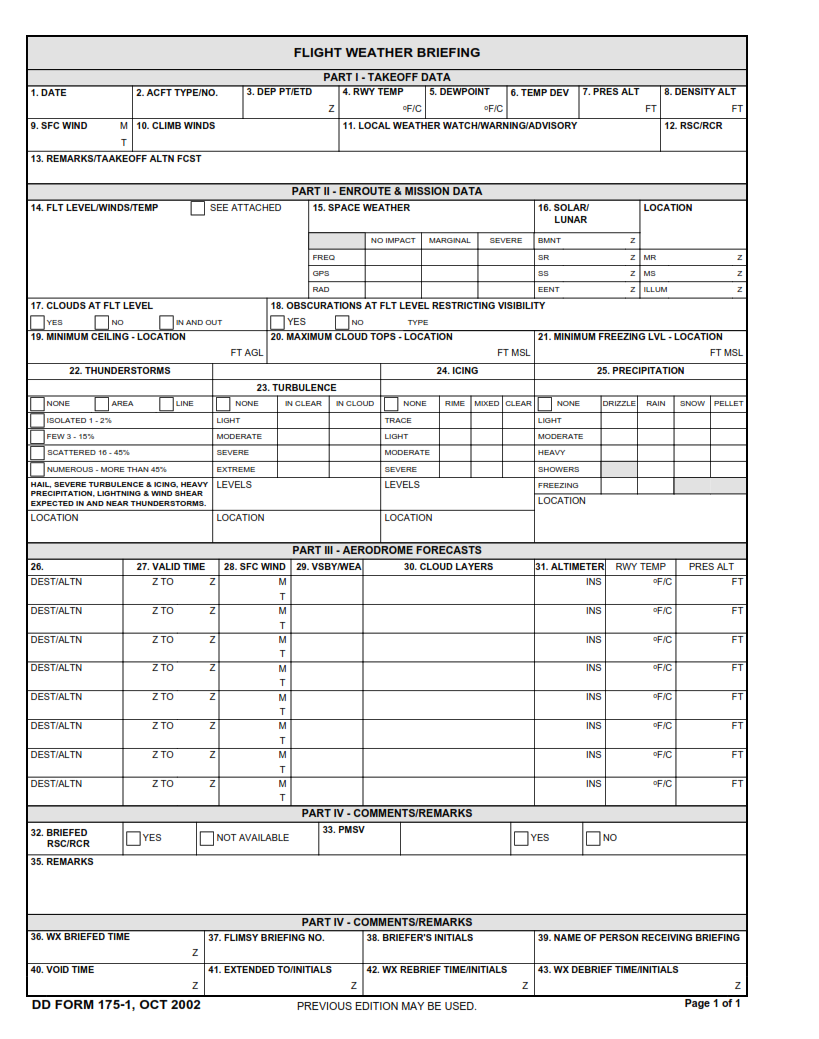ORIGINFORMSTUDIO.COM – DD Form 175-1 – Flight Weather Briefing – DD Form 175-1, also known as the Flight Weather Briefing form, is a critical document used by pilots and flight crews to obtain vital information about weather conditions. This form provides a comprehensive briefing on current and forecasted weather patterns, which allows pilots to make informed decisions when planning their flights.
Download DD Form 175-1 – Flight Weather Briefing
| Form Number | DD Form 175-1 |
| Form Title | Flight Weather Briefing |
| File Size | 125 KB |
| Date | 10/1/2002 |
What is a DD Form 175-1?
The DD Form 175-1 is a document used by pilots and flight crews to obtain important weather information before flying. This briefing helps the crew to plan their flight route, identify potential hazards, and make necessary adjustments to their plans based on the current conditions they may encounter while in the air. The form is issued by the Department of Defense (DoD) and is required for all military flights.
The briefing covers various aspects such as wind speed and direction, visibility, cloud coverage, temperature, pressure systems, turbulence reports, icing forecasts among others. Accurate weather information can help pilots avoid situations that could jeopardize their safety or cause delays in reaching their destination. Crews must complete this form at least one hour before takeoff time.
In summary, DD Form 175-1 plays a vital role in ensuring safe military flight operations. It provides crucial weather information that helps guide decision-making processes for pilots and crews before takeoff to ensure they arrive at their destinations safely.
What is the Purpose of DD Form 175-1?
DD Form 175-1, also known as the Flight Weather Briefing form, is a crucial document used by military pilots to receive weather information before and during their flight. The purpose of this form is to provide pilots with a comprehensive briefing on current and forecasted weather conditions along their planned route of flight. This information includes data on temperature, pressure systems, wind speed/direction, precipitation, cloud cover and turbulence.
The DD Form 175-1 provides vital information for pilots to make informed decisions about whether or not it is safe to fly. It allows them to assess potential hazards such as thunderstorms or icing conditions that may pose a risk to the aircraft’s safety. Pilots can then use this information to adjust their flight plan accordingly or choose an alternate route if necessary.
Overall, the purpose of DD Form 175-1 is to ensure pilot safety by providing important weather information needed for safe operation of aircraft in all types of conditions. Without access to this critical data, pilots would be unable to make informed decisions regarding the safety of their flights which could lead to potentially dangerous situations in the air.
Where Can I Find a DD Form 175-1?
The DD Form 175-1, also known as the Flight Weather Briefing form, is a critical document used by pilots to plan their flights and ensure safe travel. If you’re looking for this form, rest assured that it’s readily accessible. The easiest way to obtain it is by visiting any military installation or airfield and requesting it from the weather squadron or aviation support personnel.
In addition to getting the form in person, there are other options available. You can download a digital version of the DD Form 175-1 from various online sources or through official military websites such as Air Force e-Publishing or DoD Forms Management Program. However, keep in mind that not all websites may have an updated version of the form.
It’s important to note that using an outdated version of the DD Form 175-1 can be detrimental as aviation regulations change regularly. Therefore, always ensure that you obtain your copy from verified sources and verify its currency before use.
DD Form 175-1 – Flight Weather Briefing
The DD Form 175-1 is a vital document used by pilots in the military to receive flight weather briefing. It serves as an official record of the weather conditions and hazards that may impact their mission during flight operations. The form contains various sections, including departure, en route, destination, alternate airports, and remarks.
One of the critical aspects covered in the DD Form 175-1 is meteorological information such as visibility, cloud coverage, precipitation types and intensity, winds aloft forecast, turbulence reports and icing potential. This information allows pilots to plan their routes accordingly and make informed decisions before takeoff.
In summary, the importance of the DD Form 175-1 cannot be overstated since it provides pilots with essential data they need to ensure safe and efficient flights while also helping them avoid hazardous weather conditions.
DD Form 175-1 Example
